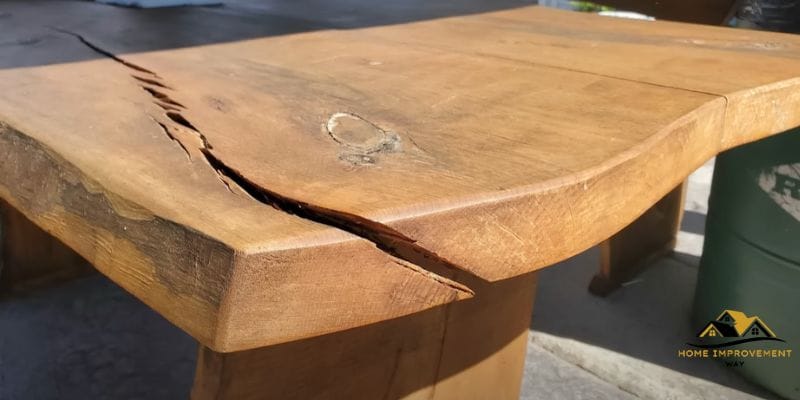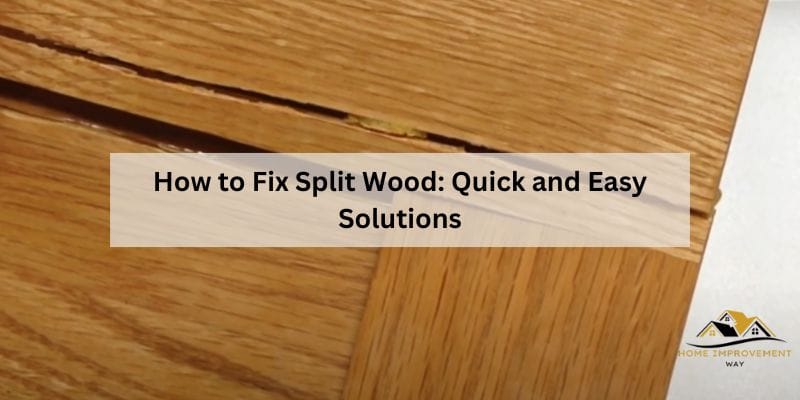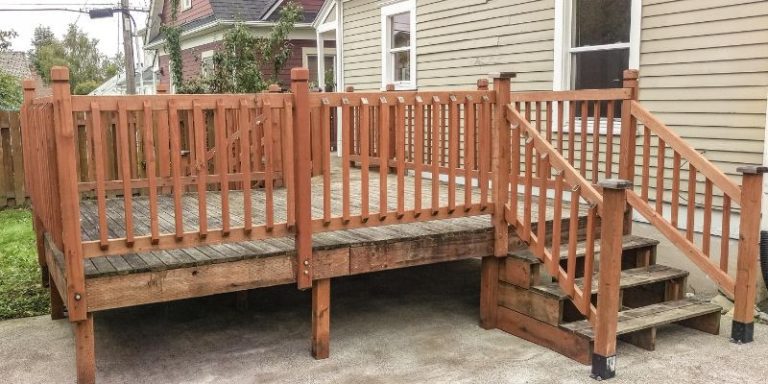How to Fix Split Wood: Quick and Easy Solutions
To fix split wood, fill the gap with wood glue and clamp the pieces together tightly. Wood is a popular material used for various purposes, but it is prone to splitting.
Split wood can be a hassle as it affects both the appearance and functionality of wooden objects. However, you can easily fix split wood by using a few simple steps. We will explore an effective method to repair split wood without any professional assistance.
By following these steps, you can restore the strength and integrity of your wooden pieces, ensuring their longevity. So, let’s dive in and learn how to fix split wood efficiently and effectively.
Understanding Split Wood
Understanding split wood is crucial when it comes to fixing it. This article provides practical tips and techniques to repair and prevent wood splitting, ensuring durability and longevity for your projects.
Split wood is a common issue that many homeowners and woodworkers face. It occurs when a piece of wood breaks or separates along its grain, causing a split or crack. While this can be frustrating, understanding the causes and types of split wood is essential for effectively fixing the problem. In this article, we will discuss the causes of split wood, the different types of split wood, and provide some tips on how to fix it.
Causes of Split Wood
There are several factors that can contribute to the splitting of wood. By understanding these causes, you can take preventative measures to avoid future damage. Here are some common reasons why wood may split:
1. Insufficient moisture content: When wood has too little moisture, it becomes dry and brittle, making it more prone to splitting. This often occurs when the wood has not been properly seasoned or dried before use.
2. Rapid moisture loss: Exposing wood to extreme temperature changes or low humidity can cause rapid moisture loss, leading to splits. This is common in environments with high heating or in arid climates.
3. Knots and irregularities: Wood with knots or other irregularities is more likely to split as these areas have weak points along the grain. Always examine the wood for any imperfections before use.
Types of Split Wood
Split wood can be categorized into different types based on the location and severity of the splits. Understanding these types will help you determine the appropriate method for repair. Here are the most common types of split wood:
1. Surface splits: These splits occur only on the surface of the wood and do not extend into the deeper layers. They are often caused by changes in moisture content or fluctuations in temperature.
2. End splits: As the name suggests, end splits occur at the ends of the wood. They are usually the result of excessive drying or insufficient sealing during the woodworking process.
3. Deep splits: These splits penetrate deep into the wood and can compromise its structural integrity. They often occur due to mechanical stress or aging of the wood.
Repairing split wood requires a combination of preventive measures and effective repair techniques. By addressing the causes and understanding the types of split wood, you can take the necessary steps to fix the issue and ensure the longevity of your wood projects. In the next section, we will share some helpful tips and methods for repairing split wood.

Quick Fixes For Split Wood
When you notice splits in your wood, don’t panic! There are simple and effective ways to fix split wood without having to replace the entire piece. In this article, we will explore three quick and easy methods to repair split wood: using wood glue, using toothpicks and wood filler, and using epoxy resin.
Using Wood Glue
If you have a clean and straight split in your wood, using wood glue can be a straightforward solution. Here’s how to fix the split using wood glue:
- Start by clamping the split ends as close together as possible.
- Apply a generous amount of wood glue along the split, making sure to cover the entire area.
- Hold the split ends together firmly and wipe off any excess glue with a damp cloth.
- Allow the glue to dry completely before removing the clamps.
- After the glue has dried, sand the area to make it smooth and even with the rest of the wood.
Using Toothpicks And Wood Filler
If the split in your wood is wider or has missing chunks, using toothpicks and wood filler can provide a more secure and durable fix. Here’s how to fix split wood using toothpicks and wood filler:
- Start by cleaning the split with a brush or vacuum cleaner to remove any loose debris.
- Take a toothpick and dip it into wood glue, then insert it into the split, making sure it goes all the way in.
- Continue inserting toothpicks in the same manner, spacing them evenly along the split.
- Once all the toothpicks are in place, squeeze wood filler into the split, filling in the gaps completely.
- Smooth out the filler using a putty knife, ensuring it is flush with the surface of the wood.
- Allow the filler to dry according to the manufacturer’s instructions, and then sand the area until it is smooth and even.
Using Epoxy Resin
If you are dealing with a large split or a piece of furniture that requires a more heavy-duty repair, epoxy resin is the way to go. Here’s how to fix split wood using epoxy resin:
- Start by preparing the epoxy resin according to the manufacturer’s instructions.
- Apply a layer of epoxy resin to both sides of the split using a brush or spatula.
- Press the split ends together firmly and hold them in place until the epoxy resin sets.
- Wipe away any excess resin with a damp cloth, being careful not to disturb the bond.
- Allow the epoxy resin to fully cure, typically overnight or as recommended by the manufacturer.
- Finally, sand the repaired area to achieve a smooth and finished look.
With these quick fixes, you can easily repair split wood and give your furniture or woodworking projects a new lease on life. Whether you choose wood glue, toothpicks and wood filler, or epoxy resin, just remember to follow the instructions carefully and take your time for the best results.

Long-term Solutions For Split Wood
Split wood can be a frustrating and common problem for anyone working with wood. However, there are long-term solutions that can help prevent splitting and keep your wood in good condition for years to come. In this section, we will discuss three key strategies for preserving the integrity of your wood: preventing split wood, proper wood storage, and regular wood maintenance.
Preventing Split Wood
Prevention is always better than cure when it comes to split wood. By taking a proactive approach, you can minimize the chances of your wood splitting in the first place. Here are some expert tips to help you prevent split wood:
- Choose the right type of wood: Different types of wood have different levels of natural resistance to splitting. Hardwoods like oak and maple are generally less prone to splitting than softwoods like pine or cedar.
- Use proper woodworking techniques: When working with wood, it’s important to use the correct tools and techniques. Avoid using excessive force or applying too much pressure, as this can weaken the wood and increase the risk of splitting.
- Pre-drill before screwing or nailing: When attaching two pieces of wood together with screws or nails, pre-drill pilot holes to prevent the wood from splitting. This helps to relieve the pressure and reduces the chances of splintering.
Proper Wood Storage
Proper storage is crucial for maintaining the integrity of your wood over time. Here are some tips for storing your wood correctly:
- Keep your wood dry: Moisture is one of the leading causes of split wood. Ensure that your wood is stored in a dry location, away from damp areas and any sources of water or humidity.
- Provide adequate ventilation: Good airflow is essential for preventing moisture buildup in stored wood. Allow for proper ventilation by stacking your wood in a way that allows air to circulate around it.
- Protect your wood from pests: Wood-boring insects can weaken the structural integrity of your wood, making it more prone to splitting. Regularly inspect your wood for signs of infestation and take appropriate measures to eliminate any pests.
Regular Wood Maintenance
Maintaining your wood on a regular basis can help prevent splitting and prolong its lifespan. Here are some maintenance tasks you should consider:
- Apply wood sealant or finish: Applying a protective sealant or finish can help shield your wood from moisture, UV rays, and other damaging elements. Be sure to choose a high-quality product suitable for your specific type of wood.
- Keep wood clean: Regularly clean your wood to remove any dirt, debris, or mold that may accumulate over time. Use a gentle cleanser and a soft brush to avoid scratching the surface.
- Inspect for damage: Periodically inspect your wood for any signs of damage, such as cracks or splinters. Address any issues promptly to prevent further deterioration.
By following these long-term solutions for split wood, you can protect your wood and enjoy its beauty and functionality for years to come.
Conclusion
Fixing split wood is a simple process that can be done by anyone with the right tools and techniques. By following the steps outlined in this blog post, you can save yourself time and money by repairing damaged wood instead of replacing it.
Remember to assess the severity of the split, choose the appropriate repair method, and take the necessary precautions to prevent future damage. With a little bit of patience and effort, you can restore your wood to its former glory and prolong its lifespan.







